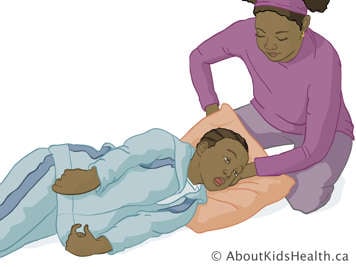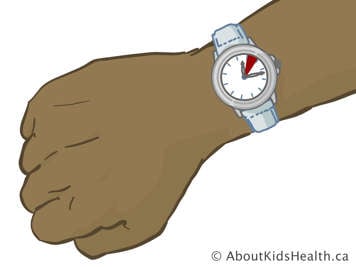What are febrile seizures?
A febrile seizure or febrile convulsion is a seizure caused by a fever. A fever is a temperature of 38°C (100.4°F) or higher. If your child has a febrile seizure, it does not mean they have epilepsy.
A child having a febrile seizure may have any of the following.
- Stiffening of the limbs or the body
- Short, sudden jerking movements of the muscles that cannot be controlled
- Rolling back of the eyes into the head
What causes febrile seizures?
Febrile seizures are most common in children between the ages of six months and five years. Febrile seizures often run in families. Children with parents or siblings who had febrile seizures are more at risk to of having them as well.
Risk of another febrile seizure
Children who have had one febrile seizure are at risk for having another febrile seizure. This is called a recurrence. A febrile seizure will not necessarily occur every time the child has a fever. Most recurrences happen within one year of the first febrile seizure and almost all occur within two years. A child is more likely to have recurrent febrile seizures if they are younger than 12 months when they have the first seizure and if they have a parent or sibling who has had febrile seizures or epilepsy.
Febrile seizures do not cause brain damage
A child's appearance during a febrile seizure can be quite frightening for parents. However, brief seizures do not damage the brain or cause permanent changes in the brain. Most febrile seizures last only a few minutes. Even if your child has a long febrile seizure, the risk of brain damage is low.
Treating your child's fever
Fever may be caused by almost any childhood illness or infection. Often, febrile seizures happen just as your child's temperature starts to rise. You might not yet know that your child has a fever. If your child feels warm, check their temperature with a thermometer. Do not put your child in the bathtub.
Acetaminophen and ibuprofen to treat fever
Give your child acetaminophen or ibuprofen if they have a fever. Read the instructions on the medicine bottle carefully to find out how much medicine to give and how often to give it. If you are not sure, check with your doctor or pharmacist.
Treating your child's fever with medicine may help make your child more comfortable. However, they will not prevent febrile seizures. Do not try to give fever medicine while your child is having a seizure. Wait until the seizure is over.
Medicines to prevent febrile seizures
Some anti-seizure medicines (anticonvulsants or anti-epileptic drugs) can reduce the risk of recurrent febrile seizures. However, these medicines have side effects so children who have febrile seizures are usually not prescribed them.
If your child often has febrile seizures, they may be prescribed a short-acting anti-seizure medicine to give at home if your child has a seizure that does not stop on its own. Your child's health-care provider will explain how to care for your child and when you need to seek medical attention.
What to do if your child is having a febrile seizure
If your child is having a seizure, stay calm and take the following steps:
- Keep your child away from sources of danger. Remove nearby objects that are sharp or hard.
- Do not hold your child down or try to stop their movements. If you can, lie your child on the floor, roll them gently on their side or roll their head to the side so that any fluids can drain out of their mouth.
-

Try to put something soft like a folded jacket under your child's head. Remove any tight clothing, especially around your child's neck. Remove glasses so they do not break.
- Do not try to put anything in your child's mouth. This could cause choking or broken teeth.
-

Your child's health-care provider will want to know how long the seizure lasts. If you can, look at a clock or your watch to see when the seizure starts and ends.
- If your child is younger than six months old or if the seizure lasts more than three minutes, call an ambulance right away.
- If the seizure lasts less than three minutes, take your child to their health-care provider or clinic right away. If the clinic is not open, take your child to a hospital emergency department.
Clothing
Keep your child lightly dressed. Remove heavy bedclothes such as blankets or comforters.
What to expect after the seizure
Sometimes children are confused or drowsy after a seizure and need to sleep for a while. Do not wait until your child has returned to normal to seek medical attention. Do not give your child any water, food or medicine until the seizure is over and they are fully alert.
You do not need to give your child special treatment
All children get sick sometimes, especially young children. Treat and protect your child the same way as any other healthy child. Remember, fevers and seizures can start suddenly, and children require supervision.
Febrile seizures usually go away on their own when the child is older
Febrile seizures do not necessarily mean that your child will have epilepsy later in life. Fewer than five per cent of children who have febrile seizures develop epilepsy.
What to expect at the clinic or hospital
A health-care provider will ask you to describe the seizure carefully, including how long it lasted and how your child looked and moved. It is helpful to describe whether the shaking started in one side of the body first, could be stopped with gentle holding, or if the jerking movements persisted.
Your child will be examined to look for a cause for the fever. Sometimes children will undergo laboratory tests to find the source of the fever.
If your child had a typical febrile seizure, they probably will not need to stay in the hospital. However, if your child has had an atypical febrile seizure (lasting for longer than 15 minutes, more than one seizure in a 24 hour period, or if they are not back to themselves and alert a few hours after the seizure) then the health-care provider may order tests and keep the child in the emergency room or in the hospital until the child is safe to return home.
